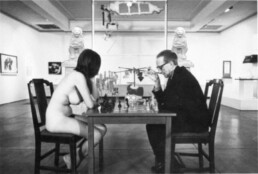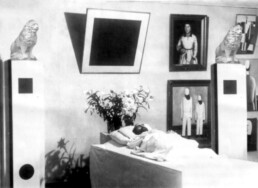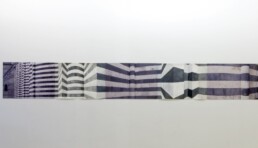MILETA PRODANOVIĆ (1959)
The Artist Who Does Not Cite Malevich Is Not an Artist
computer collage – modified historical photograph
70 cm x 100 cm
edition: 1/5
2007
The Artist Who Does Not Cite Duchamp Is Not an Artist I
computer collage – modified historical photograph
70 cm x 100 cm
edition: 1/5
2007
The Artist Who Does Not Cite Duchamp Is Not an Artist II
computer collage – modified historical photograph
70 cm x 100 cm
edition: 1/5
2007
Orvieto
installation: print on aluminum and drawing/gouache
70 cm x 1100 cm
2010
The History of Young Prodanović
three-channel video installation
10’7″
2017
The Artist Who Does Not Cite Malevich Is Not an Artist
computer collage – modified historical photograph
70 cm x 100 cm
edition: 1/5
2007
The Artist Who Does Not Cite Duchamp Is Not an Artist I
computer collage – modified historical photograph
70 cm x 100 cm
edition: 1/5
2007
The Artist Who Does Not Cite Duchamp Is Not an Artist II
computer collage – modified historical photograph
70 cm x 100 cm
edition: 1/5
2007
Not abandoning citation as an explicit memory of culture (as the author himself points out), and communication through metaphor – important drivers of Prodanović’s art production, he created the cycle The Year of the Lion in the period 2007-2008. “Critical and sarcastic reflections on deviations of consumer culture and its impact on the social, cultural, aesthetic and visual norms and values, that characterized contemporary Serbia in the first decade of the 21st century and its hypertrophied brand fetishism form the backbone of the cycle.” Two ironical conceptual works in the form of computer-modified historical photographs stand out in it: The Artist Who Does Not Cite Malevich Is Not an Artist and The Artist Who Does Not Cite Duchamp Is Not an Artist, exhibited at the 48th October Salon Micro-Narratives, 2007.
“As in his previous work, Prodanović reflects on the phenomenon of losing of the original substance of symbols and meanings in the culture of the late 20th and early 21st centuries, due to frequent use and misuse of the meanings and original intentions of the avant-gardes, especially Malevich’s and Duchamp’s works.”
Lidija Merenik, Mileta Prodanović: biti na nekom mestu biti svuda biti, Foundation Vujičić Collection, Belgrade, 2011, p. 122
“A pair of lions at the gate is an archetypal image; they guard something precious. Of course, this can be seen as ‘bad taste’, explained as a need to express power, especially in the times of poverty and uncertainty. But in this gesture of ‘decorating’, on the elemental level, there is a private need for the beautiful. At the opposite end of the wide field of art, there are icons of the avant-garde. One gets the impression that most of the art production of the second half of the twentieth century is, in fact, a dialogue with a few giants, with their work but also with their ‘image’. In this dialogue, the persons who challenged the conventions were slowly becoming indisputable and untouchable. A simple collage gesture is not just the intersection of the ‘high’ and ‘low’ – it is an attempt to unobtrusively ask the question: What is it that is valuable about modern art?”
Lóránd Hegyi, Catalogue of the 48th October Salon
© Cultural Centre of Belgrade, the October Salon Collection and the artist
Gift Contract III-5-221/14.8.2014.
Inventory No. 1335, 1372, 1373
Photo: Courtesy of the artist
Orvieto
installation: print on aluminum and drawing/gouache
70 cm x 1100 cm
2010
The painter, writer, critic, one of the most prominent figures on the art scene of the eighties and one of the most important authors of postmodernism in Serbia Mileta Prodanović, in his work in the field of visual art, uses rich national and world historical and artistic heritage, especially Byzantine, through collage and citation procedures.
According to the art historian Prof. Dr. Lidija Merenik, from the ‘invention of history’ in his 80s and 90s cycle, Prodanović reached another, his own renewal of a painting, with his recent series of paintings Ekphrases, in 2019.
“Besides many previous experiments with paintings and environments, now, as in his best paintings (Angel of History, 1997; Rolling Skies, 2004), Prodanović goes on with the ‘invention of a painting’, characteristic of his overall conceptual and painting method. His paintings, like all his works, are primarily complex semantic fields, and only consequently visual fields.”
Lidija Merenik, text for the exhibition Ekphrases, Rima Gallery, Kragujevac, 2019
The work Orvieto consists of 11-meter-long photographs and drawings, whose parallel streams of dark and light lines of the Gothic façade level the metaphor of the continuity of our life flows, travels, distance, time. In this polyptych – fragments of the Gothic façade of the Orvieto Cathedral, among which drawings/gouaches or paintings are interpolated – the concept of citation and repetition is consistently and fully implemented. But this time there is no code, either enlightening or any other, which should be deciphered. Their uniqueness lies in the subtle transition and connecting of the photographic template with the manual world of the painting and in creating the mysterious relationship between the document and memory, the past and present, matter and form, the real and the imagined, the unreturnable and unendable…
© Cultural Centre of Belgrade, the October Salon Collection and the artist
Purchase Contract: III-5-479/1/15.12.2014.
Inventory No. 1383
Photo: Courtesy the artist
Selected Bibliography:
Lidija Merenik, Mileta Prodanović: biti na nekom mestu biti svuda biti, Foundation Vujičić Collection, Belgrade, 2011
45th October Salon, Continental Breakfast. Cultural Centre of Belgrade, 2004
48th October Salon, Micro-Narratives. Cultural Centre of Belgrade, 2007
The History of Young Prodanović
three-channel video installation
10’7″
2017
The work was presented at the Genus – Family Stories exhibition in the “Nadežda Petrović” Art Gallery between 16 December 2017 and 26 January 2018. This exhibition won Mileta Prodanović Politika Award for the best exhibition in 2017.
The History of Young Prodanović belongs to the group of family stories through which Prodanović asks himself, above all: Where are we from? Who are we? Where are we going? He is searching for answers in the history of his family as well as in putting that family in a historical context of the disjointed courses which the Serbian people took in different periods of its turbulent history on the frontier. In the cycle of works titled GENUS – Family Stories, based on documents and written or told family records, Prodanović reconstructs the fragments of his family’s history, which in the 18th century took them away from their place of origin in Old Herzegovina to the north, in the direction of Western Serbia. One brother settled on the slopes of Mountain Maljen; the other went to Vojvodina. One brother’s offspring lived in a family cooperative, which was not formally abolished before the early 20th century, whereas the other branch of the family tried to find its place in the rising modern European society. Both branches struggled in new surroundings, in the states that were not theirs, in order to have a better life and stop being second-class citizens.
The basis of The History of Young Prodanović is a folk song about Mihailo Prodanović, a young military leader in the army of Empress Maria Theresa, who fought in the War of the Austrian Succession from 1740 to 1748, and whose merits earned him a medal and noble status.
“This work is created as a video projection with the images of the facades of baroque buildings in Donauworth, at whose openings inserts from films dedicated to this period (including Saša Petrović’s Migration) are alternately shown, while the song The History of Young Prodanović is performed with the gusle accompaniment. Such an audio-visual composition carries us over into the bloody battles described in the memoirs of Simeon Piščević, in which Vuk Isakovič and the Slavonian-Danube regiment died, and into the clash between the capricious European rococo architecture and the terrifying Balkan sound. The symbolism of the repetitive temporal course of history is marked by two projections of waterfalls, which laterally close the central space of the exhibition.”
Introduction to the exhibition Genus – Family Stories, Čedomir Vasić
“All my works, after all, testify to the times in which I live… There are different media and other kinds of variety in my works, it is a face of freedom offered by the ‘time of dispersion’ which followed after the dissolution of the ‘grand narratives’ of modernism. Of course, the position of freedom in expression should be won as well as preserved. I believe there is in any case some kind of constancy about my work, which may not be obvious at first glance, but which persists in the need for the metaphor, indirect speech, or parabole.”
A suitcase of Mileta Prodanović’s historical memories, curator Julka Marinković’s interview with the author.
The gusle, voice: Danilo Krstajić; Sound recorder: Vladimir Sl. Janković; Image processing and montage: Filip Čekić
© Cultural Centre of Belgrade, the October Salon Collection and the artist
Purchase Contract: III-5-299/22.10.2021.
Inventory No.
Photo: Courtesy the artist
Selected Bibliography:
Mileta Prodanović, GENUS – porodične priče, 16. XII 2017 – 26. I 2018, Art gallery „Nadežda Petrović“, Čačak, Serbia, exhibition catalogue.
ABOUT THE AUTHOR:
Mileta Prodanović (1959, Belgrade, Serbia) graduated (1983) and received his master’s degree (1985) from the Faculty of Fine Arts in Belgrade; completed specialist studies in London, at the Royal College of Arts, 1989–1990; earned the title of Doctor of Fine Arts at the Faculty of Fine Arts in Belgrade in 2009. Since 1990 he has been working at the Faculty of Fine Arts in Belgrade, currently as a full professor. In the period 2015–2018, he was a vice-rector and from 2018 to 2019, the rector of the University of Arts in Belgrade. Since 2011 he has been a member of the National Council for Culture of the Republic of Serbia, and in the period 2015-2019, the president of that body.
Since 1980 his works have been presented at numerous solo and group exhibitions in Yugoslavia and in several European cities (Rome, Tübingen, Toulouse, Carcassonne, Venice, Vienna, Graz, Prague, Regensburg, Kiev…) and America (Clear Lake – Houston, Columbia – South Carolina). He exhibited at the Venice Biennale, Yugoslav Pavilion in 1986; participated in the 45th October Salon: Continental Breakfast (2004) and the 48th October Salon: Micro-Narratives (2007).
In 1983 he started publishing fiction, essays on visual arts and non-fiction; was a member of the editorial boards of the Beogradski krug Magazine, New Moment (magazine for visual media) and Kultura.
His works are part of the most prominent museum and private collections in Serbia, the countries of the former Yugoslavia and Europe. A laureate of a number of most prestigious national awards in the fields of literature and fine arts. Lives in Belgrade.



